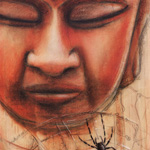Ken is in the process of creating a new teaching called “The Fourth Turning – Imagining the Evolution of an Integral Buddhism.” This teaching is being published as videos and an E-book this year and a new hardcover book in 2015. This blog post is the fourth excerpt of a summary of this new teaching.
These three different interpretations and experiences of the same meditative event are not just speculative. There are already entire schools of Buddhism that come essentially from one or the other of those particular three major developmental levels (Magic, Mythic, and Rational).
Melford Spiro in his work Buddhism and Society divided Burmese Theravada into three groups, and they are almost exactly Magic, Mythic, and Rational. The first, which he calls Apotropaic Buddhism, is primarily concerned with protection from evil spirits, using items such as magical charms and incantations. This is pure Magic.
Spiro’s second group he calls Kammatic Buddhism, which is focused on generating merit for a future rebirth. This is a typically Mythic View with some magic elements. There is also the ethnocentric warfare of the Sinhala Buddhists fighting in Sri Lanka. They possess all of Marty and Appleby’s “family resemblances” of mythic-literal fundamentalists—a strong sense of religious identity (a “true believer”), strict social boundaries (us vs. them—a “chosen peoples”), reliance on myth, and so on. Sinhala Buddhists see themselves as “owners and protectors of the Buddhist teachings”; Sri Lanka as the home of the true Dharma; they have control over the purity and right version of the Dharma; and are “ethnic chauvinists” in constant warfare (holy war) with Tamil Hindus, the enemy of truth. This is, indeed, almost pure ethnocentric and absolutistic Mythic stage.
Spiro’s third group he calls Nibbanic Buddhism—they are interested in attaining Nirvana through state-realization as described by Theravada. This Rational Buddhism (including its emphasis on states) was probably the closest thing we have to Gautama Buddha’s original teaching. The Rational nature of Early Buddhism also meant it was not ethnocentric, as Mythic is, but worldcentric (which treats all people—not as being a member of an “in group” versus an “out group”—but equally, regardless of race, color, sex, or creed). Hence, Early Buddhism opened itself to the untouchables, usually excluded from other religions. This was a major factor in Buddhism’s rapid spread through India. And “rational” doesn’t mean it was only rational, but that it had rational capacities; there were few if any myths, gods, goddesses, elemental spirits, and so on (it wasn’t Magical, and it wasn’t Mythic). The texts were quite rational, and pointed to ways to change consciousness through meditative techniques (whose experiences were themselves trans-rational, but whose explanations and guidelines were cleanly rational or reasonable).
So this is already happening—Buddhist state experiences are already being interpreted in profoundly different ways based on general developmental levels. And this is continuing today. One of the most recently emerged developmental levels is, after Rational, the Pluralistic. The Pluralistic View is marked by deep social concern and powerful drives of social justice; is egalitarian and anti-hierarchical; is seriously concerned with environmental and ecological issues; argues for sustainability and renewable energy; downplays any sort of ranking; is anti-patriarchal and anti-war; is profeminist; and is profoundly socially engaged. It is, in other words, the standard form of Buddhism in the Western world. Socially engaged Buddhism is a prime example.
The point is that not only can entire schools be based on essentially the elements of a given level (and not know it), but individuals can themselves have the same thing happen, in one of two major ways: they can be at a given developmental level (say, Pluralistic), and experience the entire sequence of meditative stages (e.g., gross, subtle, very subtle, nondual), all the way to Enlightenment, but each interpreted from the Pluralistic level; or they can progress through the levels of development at the same time they are progressing through the meditative stages (and in any number of combinations, such as starting the gross stage at Mythic; experiencing the subtle and very subtle stages at Rational; interpreting the witnessing mirror mind at Pluralistic; and the nondual stage at Integral—or virtually any other combination). But the point is that, they won’t be aware of these structure-interpretations because, again, structures can’t be seen by introspecting, only their results.
Once you become aware of the vast literature on developmental levels (and in the many different lines), you can fairly easily spot when a meditation teacher is coming from a particular level. This gives various teachers sometimes slight, sometimes significantly different views of Buddhadharma, just as the above-mentioned schools of Buddhism have actually quite different versions of Dharma based on developmental levels. The concern, of course, is that many of the greatest Buddhist texts are coming from at least an Integral level of development (and a nondual state level), but they are being interpreted by teachers at considerably lower levels, simply because these levels can’t be spotted unless you actually study various maps of that developmental territory. And thus any truly comprehensive meditative system would want to be aware of this double development—development occurring in states and development occurring in structures—and thus include both states of consciousness and structures of consciousness in their teachings—the states being how we WAKE UP, and the structures being how we GROW UP. Both, needless to say, are profoundly important.
The addition of structures and their stage-levels is one of the most important items that a new Turning would include, in my opinion, simply because of the profound (and usually completely unknown) impact it has on so many aspects of reality and its experience—and aspects that Buddhism has traditionally shown an exceptional interest in—and thus I have spent by far the largest amount of time in this intro on that topic. Many of the other items are as, or nearly as, important, but I will simply give a very short mention of them, leaving a fuller discussion to be found in the other works I mentioned (as well as my Integral Spirituality, which covers many of these topics in detail).
In the next blog post Ken will talk about shadow work and it implications to the Fourth Turning of Buddhism
GO DEEPER
The Fourth Turning Media Collection
Use special code PTHEOS and get a discount on the price of the Fourth Turning Media Collection.
The Fourth Turning Media Collection focuses on Ken’s NEW teaching videos on the evolution of Buddhism and how the Integral perspective informs the transformation of Buddhist teachings and practice in the 21st Century.
Once Ken has established the ground of the Fourth Turning inquiry, Diane Musho Hamilton, Doshin Michael Roshi and Patrick Sweeney teach and demonstrate practices with their respective sangha’s that suggest how what Ken is pointing out actually manifests in a Buddhist setting.
At lastly, other progressive and Integral authors, teachers and practitioners share their thoughts on what they think should be included in an inquiry into a 4th Turning of Buddhism from an Integral perspective.
The Fourth Turning Conference – April 4-6, 2014
Sign up for the Fourth Turning Conference by February 28th and receive special early bird pricing.
Join us for this live historic three day event where we will deeply explore the Fourth Turning of Buddhism with Ken Wilber (live and in person) and Integral Buddhism teachers, Diane Musho Hamilton, Doshin Michael Nelson Roshi and Patrick Sweeney. Plus we will be joined by other skilled Buddhist authors and practitioners reflecting on the now and future of Buddhism from an Integral perspective.











